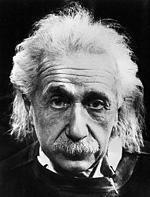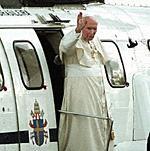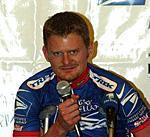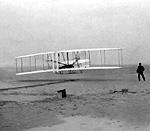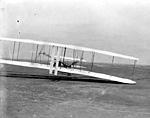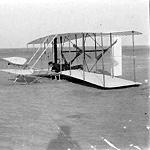
Recently on Cyclingnews.com |
Tales from the (Freakin' Genius) Peloton, December 17, 2003
Team Lardbutt aren't the fastest team in the US, they aren't the best equipped team, and we aren't even sure if they really exist. But they are funny (usually) and have some great tales to tell about the races they compete in (if they make it).
Freakin' Geniuses
-or-
How A Couple Of Cyclists Built And Flew The First Successful Airplane 100 Years Ago This Month
By Greg Taylor
It doesn't take a freakin' genius to figure out that folks who fiddle with bikes are sometimes, well, freakin' geniuses. I don't mean just your plain vanilla genius; what I'm talking about here is the mad scientist uber-brainiac "It's Alive!!!!!" kind of genius. The kind of genius that invents important stuff like ketchup or figures out all of the cheat codes for Grand Theft Auto III.
|
|
|
|
|
|
|
|
|
|
|
|
Don't believe me? Then perhaps few examples are in order:
Albert Einstein: You can't argue with this one. Einstein is the pimp-master Mac-daddy of geniuses everywhere. Period. End of story. And he rode a bike. Einstein once said that the Theory of Relativity was just something that he thought up while he was out on his bicycle.
The Pope: Yes, the Pope. In addition to leading one of the world's major religions, Pope John Paul II is also a hard-core bike guy. Try this on for size: His Holiness has a gold plated Colnago. Full Campy Record. Bike-nut credentials don't get much more bona fide than that. Can I get an "Amen!" from the congregation?
Floyd Landis: Otherwise known as Floyd Landis, Boy Genius. Yes, he's an incredibly strong rider. However, his defining moment of true genius-hood came when he single-handedly won the 2002 Tour de France for Lance and Company by unleashing the power of ZZ Top's Greatest Hits on the U.S. Postal team bus. Purveyors of industrial grade Texas Rock-N-Roll, one listen to ZZ Top was enough to (1) rejuvenate and inspire a certain Texan to victory in the Tour, and (2) instill a sense of shock and awe in his Continental teammates by demonstrating that, as products of a culture capable of producing and enjoying such an aural onslaught, the Americans in peloton were not a group to be trifled with. None of that sensitive Yanni At The Acropolis chick music or Euro techno crap for them.
No, if you want to inspire the Americans, you had better give them a band with a big-ass boogie guitar attack and big beards. ZZ Top fills the bill perfectly. As a postscript to this story, there are unconfirmed rumors that fallout from the 2002 ZZ Top Incident may have indirectly led to the departure of Roberto Heras from U.S. Postal for 2004. Previously suppressed reports suggest that, in addition to his climbing prowess, one of Heras' duties during the 2003 Tour was to sing a medley of ZZ Top classics, including La Grange and Lance's special favorite, Tush, when the team was in the mountains. "Yes, I heard it while Lance was climbing up the Col du Bargaguy," reports one unnamed journalist. "Roberto was just miserable… when they went by me, I think that he [Heras] was singing the chorus to She's Got Legs. Lance and Floyd looked like they were about to bust a gut, trying not to crack up."
Still aren't impressed? Okay, how about this: on December 17 of this year, anyone who rides or tinkers with bicycles should give a reverent tip of the helmet to two brothers from the United States who have a permanent spot in the Freakin' Genius Hall of Fame - Wilbur and Orville Wright, the inventors of the modern airplane.
Yes, the airplane was invented by a couple of cyclists. And why should we think about them on December 17? Because it's the 100th anniversary of the Wright's first powered flight at Kitty Hawk, North Carolina. The first controlled, powered flight anywhere.
Sure, the story of the Wright brothers' accomplishments in aviation and solving the basic problem of controlled, powered flight is well-known. Somewhat less well-known are the brothers' accomplishments as riders and bicycle manufacturers.
Starting in 1897 and continuing into the early 1900's, the Wright brothers built and sold two different lines of handmade bicycles out of their bicycle shop in Dayton, Ohio. The top of the line was the Van Cleve, which was named after the first settlers of the town of Dayton. Made to order, the Van Cleve was a very impressive machine for the time. Most of the frames were cut and brazed by the Wrights in the workshop behind their bicycle store, and then dressed with components selected by the customer. A buyer could specify wooden or metal rims, a choice of bars, saddles, gearing, and other little details. Of special interest are the hubs: the Wrights designed and built their own special hub sets, including a model that featured a coaster brake. Each frame was treated to five coats of hand-brushed rubberized enamel - hand-brushing was favored over dipping as it produced a thicker coat of paint. The Wrights also produced a line known as the St. Clair, which was priced more affordably. Some of the St. Clair bicycles may have had frames built by the Pope bicycle company, which was one of the largest cycle manufacturers of the day. Another interesting tid-bit is that the Wrights bought components from the Davis Sewing Machine Company, a local company owned by George P. Huffman. Davis Sewing Machine Company later emerged as the well-known Huffy Bicycle Company.
From all reports, the bikes built by the Wrights were fine machines and gave excellent service. More importantly, the money earned by the Wrights from their bicycle business (about $3,500 a year) was used to fund their flying experiments. Not surprisingly, much of the technology that the Wright brothers used to build their bicycles transferred over to their first airplanes. For example, the 1903 Wright Flyer, the first successful heavier-than-air aircraft in the world, trundled down the take-off rail and into aviation history on an old set of bicycle hubs. The wings were braced using bicycle spoke wire, and bicycle-style chains and sprockets drove the propellers. All of the Wright's early gliders and airplanes were built at their bike shop in Dayton, and then shipped to Kitty Hawk, North Carolina, where they were flight-tested.
Think about it: the world's first successful airplane was designed and constructed in the back of a bike store by a couple of guys from Dayton. And they weren't just any sort of guys. They were bike guys.
Freakin' geniuses, if you ask me.

